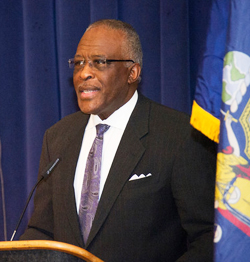Campus Community Discusses Diversity, Race and Inclusion
President Jones Continues Important Dialogue
ALBANY, N.Y. (February 25, 2016) -- On Tuesday evening, to a packed Campus Center Ballroom, President Jones invited students, faculty and staff to begin an open dialogue regarding diversity, race and inclusion on the University at Albany campus.
President Jones welcomed the nearly 200 participants and introduced Chief Diversity Officer Tamra Minor, who served as event moderator.
In his opening remarks, the President reiterated how the role of diversity is everyone’s responsibility, stating, "Rule number one in diversity work is that wherever we are on the organizational chart, all of us need to be both diversity leaders and diversity workers."
 |
|
President Jones (Photo Mark Schmidt)
|
The event featured round table discussions which were then reported back to the event panelists for further discussion. Esteemed panelists included Vivien Ng, associate professor and chair of Women's Studies; Karyn Loscocco, professor of Sociology; and Marc Cohen, MPA student.
A facilitator was also assigned to each table to help create a respectful and productive dialogue focused on the discussion questions; assist in the report out by selected tables; and encourage participants to offer their thoughts on the event.
The topics discussed included:
- As a public research university and a very large complex organizational system, with more than 17,000 students and 5,000 faculty and staff, the University at Albany is a very diverse campus community. Nonetheless, we are unlikely to share a universal experience of diversity across campus. Reflecting on your own experiences at UAlbany, what are your perceptions of diversity and inclusion at UAlbany? More specifically, what are your perceptions of race and race-relations on our campus? What do you believe are the contributing elements that have led the UAlbany community to where we are today in these areas of diversity, inclusion, race and race relations?
- As members of the University community, it is our collective responsibility to contribute to a campus community in which diversity and inclusion are valued and respected. Reflecting on your current impressions of the campus climate for diversity, consider a set of constructive actions each of us can take to move our campus community forward. Consider both strengths that we should continue as well as opportunities for improvement. What do you see as the primary contributions -- of students, faculty, staff and leaders -- to our current campus climate? What has been your role thus far in advancing diversity and inclusion on our campus?
- If you could change anything related to diversity and inclusion on our campus, what would you change? When you envision UAlbany’s future, what should be our collective vision for diversity? What is the vision that will push and pull us beyond our present reality? What are the most powerful actions that students, faculty, staff and leaders can take to advance diversity and inclusion at UAlbany? What actions can each of us take to ensure that UAlbany is experienced by all as a safe and welcoming campus? More importantly, what will be your role in bringing this vision for the future into being?
The ODI team will compile the insights shared by students, faculty and staff at the event and develop a synopsis to share with the campus community. Overall the initial reactions from participants were very positive.
"This engagement approach really works – not just for Diversity and Inclusion – but for everything we do here in a public research university," President Jones said. "This is how culture changes. This is how we create inclusive excellence, and a welcoming and safe environment for members of our community."
![]() For more news, subscribe to UAlbany's RSS headline feeds
For more news, subscribe to UAlbany's RSS headline feeds
A comprehensive public research university, the University at Albany-SUNY offers more than 120 undergraduate majors and minors and 125 master's, doctoral and graduate certificate programs. UAlbany is a leader among all New York State colleges and universities in such diverse fields as atmospheric and environmental sciences, business, education, public health,health sciences, criminal justice, emergency preparedness, engineering and applied sciences, informatics, public administration, social welfare and sociology, taught by an extensive roster of faculty experts. It also offers expanded academic and research opportunities for students through an affiliation with Albany Law School. With a curriculum enhanced by 600 study-abroad opportunities, UAlbany launches great careers.


